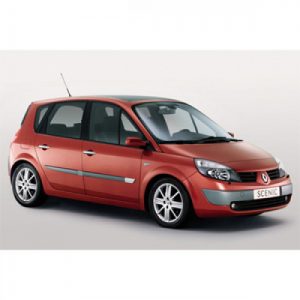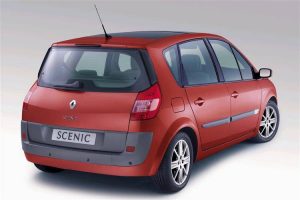Catalyst converter C138/8200063760/112729536000. Renault Scenic.
C138 / 8200063760/112729536000 Catalysts are used by the Renault brand in their cars. These catalysts have a rather unusual shape. They consist of two “pieces” – larger and smaller, the inside of which is large enough to hold a smaller ceramic insert saturated with palladium. The length of the model is slightly more than 45 cm and the weight is particularly large and exceeds 1.30 kg. This catalyst can be found in 2002. Renault Scenic, 1.6-liter engine versions in car models.
 Renault Scénic (Scénic until 1999 and Renault Mégane Scénic until 2009) is a C-segment minibus developed by the French company Renault. Scénic has been produced at the Douai plant in northern France and Brazil since 1996. Three generations are based on the design of the Renault Megane. Its competitors include Citroën Xsara Picasso, Citroen C4 Picasso, Ford C-Max, Opel Zafira, Peugeot 5008, SEAT Altea, Toyota Corolla Verso, Volkswagen Golf Plus and the Volkswagen Touran.
Renault Scénic (Scénic until 1999 and Renault Mégane Scénic until 2009) is a C-segment minibus developed by the French company Renault. Scénic has been produced at the Douai plant in northern France and Brazil since 1996. Three generations are based on the design of the Renault Megane. Its competitors include Citroën Xsara Picasso, Citroen C4 Picasso, Ford C-Max, Opel Zafira, Peugeot 5008, SEAT Altea, Toyota Corolla Verso, Volkswagen Golf Plus and the Volkswagen Touran.
The idea to create this minibus came from the original J64 project in the Megane production group. The X64co project led to the creation of Méganes, which appeared in 1996. It consisted of a series of models with a common framework offering solutions to the different needs of middle-class customers. The purpose of this model was to diversify the supply of medium-sized models rather than standardize customer needs per model.
This mid-size vehicle segment was the most important in the market. The innovative idea was then to present a group of solutions based on the average vehicle. In addition to the philosophy of the model group, a mid-range minibus appeared on the market for the first time. Until then, minibuses were just high-end vehicles. The idea of different solutions was very successful, so Megane’s competitors quickly took over the idea and carried out similar projects.
2006 October month. Renault has upgraded the Scénic variant, introducing minor aesthetic changes to the front, replacing the headlights with more modern ones with LEDs. The updated model also offered a panoramic roof and a front proximity sensor. New body colors and redesigned tires and rims were also added.
The idea to create this minibus came from the original J64 project in the Megane production group. The X64co project led to the creation of Méganes, which appeared in 1996. It consisted of a series of models with a common framework offering solutions to the different needs of middle-class customers. The purpose of this model was to diversify the supply of medium-sized models rather than standardize customer needs per model.
This mid-size vehicle segment was the most important in the market. The innovative idea was then to present a group of solutions based on the average vehicle. In addition to the philosophy of the model group, a mid-range minibus appeared on the market for the first time. Until then, minibuses were just high-end vehicles. The idea of different solutions was very successful, so Megane’s competitors quickly took over the idea and carried out similar projects.
2006 October month. Renault has upgraded the Scénic variant, introducing minor aesthetic changes to the front, replacing the headlights with more modern ones with LEDs. The updated model also offered a panoramic roof and a front proximity sensor. New body colors and redesigned tires and rims were also added.


